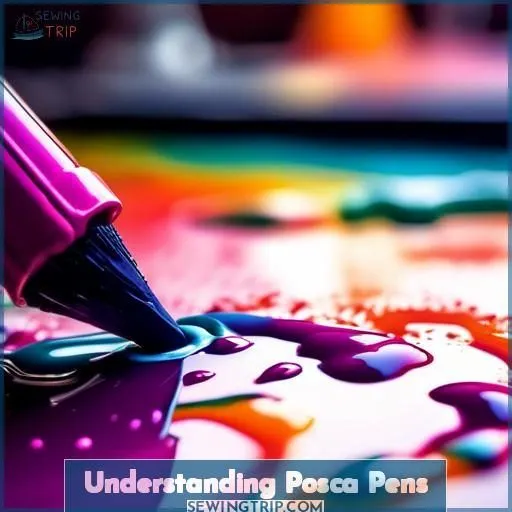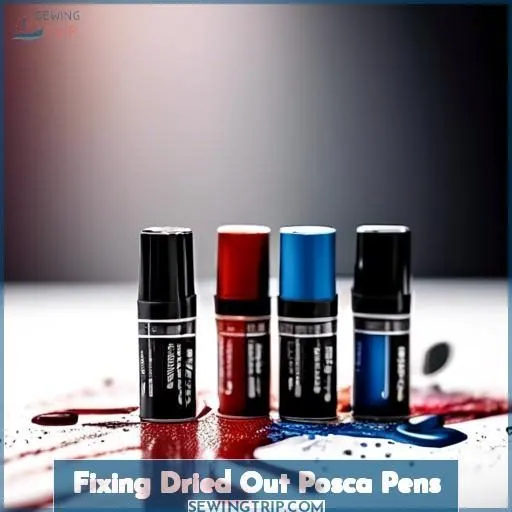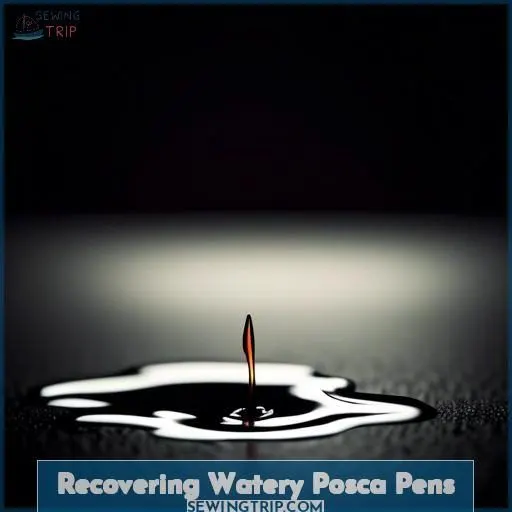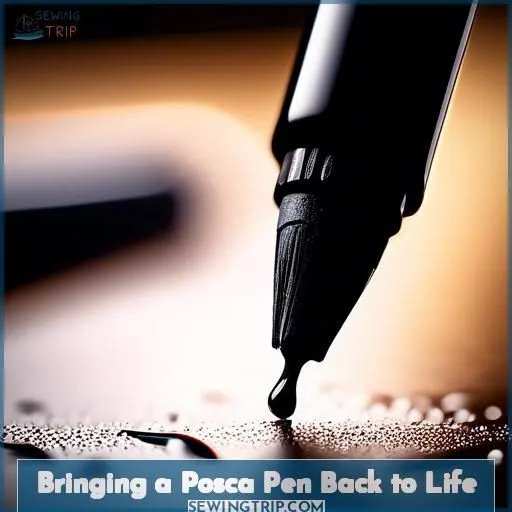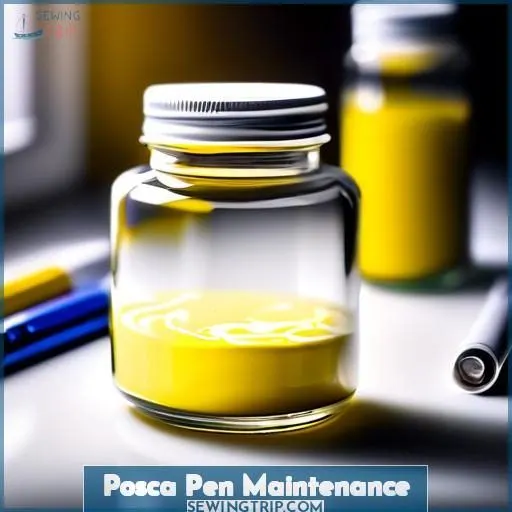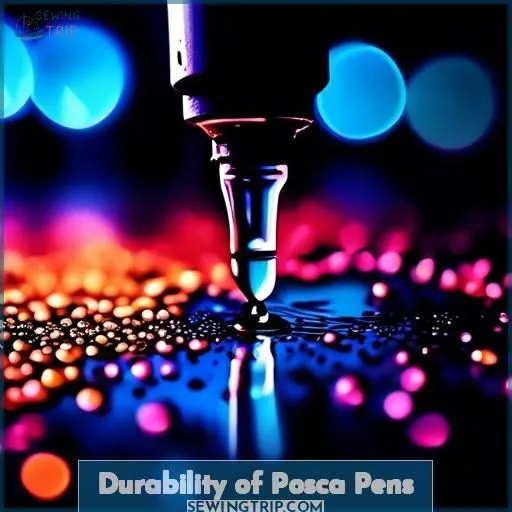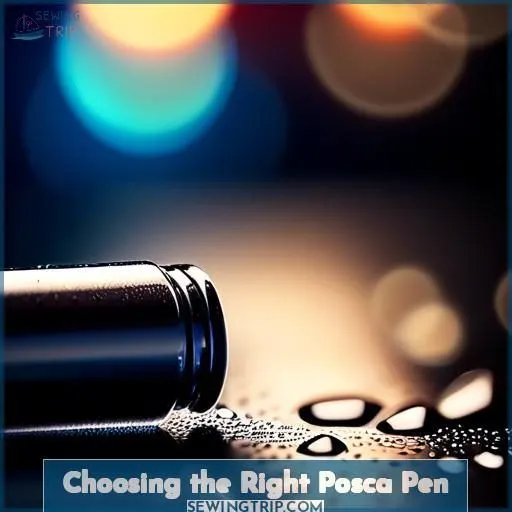This site is supported by our readers. We may earn a commission, at no cost to you, if you purchase through links.
If your Posca pens are feeling a bit too watery, fret not – there are ways to troubleshoot and rejuvenate them. Initially, inspect for air bubbles or dense paint, which can cause the watery texture. Shake the pens vigorously, or use a marker blender to assist in resolving any problems.
If that doesn’t work, consider replacing the ink cartridge. Storing your Posca pens upright and cleaning the nibs regularly will also help maintain their best performance.
With a little care and attention, you can keep your Posca markers in excellent condition.
Table Of Contents
- Key Takeaways
- Understanding Posca Pens
- Posca Pens Being Too Watery
- Fixing Dried Out Posca Pens
- Recovering Watery Posca Pens
- Bringing a Posca Pen Back to Life
- Posca Pen Maintenance
- Comparing Posca Pens With Other Markers
- Durability of Posca Pens
- Choosing the Right Posca Pen
- Frequently Asked Questions (FAQs)
- Conclusion
Key Takeaways
- Watery Posca pens can be caused by air bubbles or thick paint.
- Shaking the pens, using a marker blender, or replacing the ink cartridge can help fix watery Posca pens.
- Proper storage and cleaning can prevent watery pens.
- Posca pens are versatile and suitable for various applications, but can sometimes become watery.
Understanding Posca Pens
Posca pens are a unique type of marker that have become increasingly popular among artists and hobbyists. While these pens offer a range of features, some users have reported issues with the pens being too watery, which can impact the quality of their work.
Overview of Posca Pens
As an artist, you want your markers to perform at their best, especially with regards to Posca pens. These pens offer specific styles and pigment quality that make them a popular choice for lettering and glass art. However, they can sometimes be too watery, affecting ink flow control and color compatibility.
Fortunately, there are solutions to rescue your Posca pens, ensuring the longevity of your ink and the satisfaction of your work.
Types of Posca Pens
Posca pens come in various types, including water-based paint pens and oil-based paint markers.
Water-based paint pens are suitable for non-durable applications, while oil-based paint markers are ideal for durable applications.
Both types require shaking before use and may become watery or dried out over time.
Proper pen storage and care, such as storing pens horizontally, capping tightly after use, and avoiding extreme temperatures, can help prevent these issues.
Features of Posca Pens
Posca Pens are versatile, refillable, and come in a variety of colors and nib shapes, making them suitable for various applications.
They work on a range of surfaces, including paper, acrylic paintings, stone, concrete, ceramics, glass, fabric, plastic, and metal, with minimal bleeding or show-through. Posca Pens are perfect for painting and drawing, offering smooth and glide across surfaces.
They’re water-based and dry permanent, making them ideal for creating art on non-porous surfaces like glass and plastic. Posca Pens are suitable for signage and can be used for drawing on dark surfaces, as they’re opaque enough to produce a bright white color.
The markers are available in seven different tip sizes, ranging from ultra-fine to ultra-large chisel tips.
Posca Pens Being Too Watery
Dealing with watery Posca pens can be frustrating, but don’t despair. There are simple solutions to revive these markers and get them performing at their best again.
Causes of Watery Posca Pens
Watery Posca pens can be a frustrating issue for artists and crafters, but understanding the causes can help you fix the problem and restore the consistency of your pens. The most common cause of watery Posca pens is air bubbles in the paint, which can occur when the pens are shaken or stored in an uneven position. This can cause the ink to separate, making the pens watery. Another cause could be the paint itself. If it’s too thick, it can become watery and difficult to apply. Fortunately, there are several solutions for watery Posca pens.
To fix watery Posca pens, start by checking the pen for air bubbles. If you find any, shake the pen vigorously to help disperse them. This should help restore the consistency of the paint. If the problem persists, you can try thinning the paint with a bit of water. This should help the paint flow more freely, allowing you to produce better results.
In addition to these methods, proper storage and maintenance of your Posca pens can help prevent watery pens. Store your Posca pens horizontally to prevent ink from pooling at the tip, which can lead to clogging or damage. Handle your pens gently to avoid applying excessive pressure or force on the tips, as rough handling can cause the tips to fray or become deformed. And when storing your pens, make sure that they’re capped tightly after each use and kept in a cool, dry place to avoid extreme temperatures that can affect the ink consistency.
Effects of Watery Posca Pens
Watery Posca pens can lead to unsatisfactory results in your artwork. The main cause of this issue is air bubbles in the paint, which can occur when the pens are shaken or stored in an uneven position. This can cause the ink to separate, making the pens watery.
Another possible cause is the paint itself being too thick, which can make it difficult to apply.
Fortunately, there are several ways to fix watery Posca pens.
Solutions for Watery Posca Pens
If your Posca pens are too watery, don’t worry. Here are three solutions to restore them:
- Shake Vigorously: Give your pens a good shake to spread the ink evenly.
- Use a Marker Blender: Mix the ink inside the pen to make certain it’s well combined.
- Replace the Ink Cartridge: If the issue continues, think about replacing the ink cartridge.
Fixing Dried Out Posca Pens
Has your Posca pen dried out? Don’t fret – with a bit of effort, you can breathe new life into those watery markers. Try shaking the pen vigorously, using a marker reactivator, or even soaking it in warm water to get that ink flowing again.
Shaking the Pens
Shaking your Posca pens is a simple yet effective method to revive dried-out markers. Different techniques, shaking intensity, and duration can all impact the success of this method.
For best results, try shaking for at least 15 seconds. Remember, patience is key – keep shaking until the ink starts to flow freely.
Shake the pen vigorously in various directions to make sure the ink flows smoothly again.
Using a Marker Reactivator
If your Posca pen is too watery, it can be frustrating and may affect the quality of your work. Here are four solutions to help you recover your markers:
- Shake Vigorously: Sometimes, simply shaking the pen can help distribute the ink evenly and restore its consistency.
- Use a Marker Reactivator: These products are designed to revive dried-out markers by reactivating the ink.
- Soak in Warm Water: Submerge the pen in warm water for a short period to help the ink flow more smoothly.
- Replace the Ink Cartridge: If the pen is beyond repair, consider replacing the ink cartridge with a new one.
Soaking in Warm Water
When your Posca pen’s nib acts up and dries out, pamper it. Submerge it in a relaxing bath with perfect water temperature. Let it unwind—timing is crucial, so don’t hasten the soaking process. Select a cozy container that accommodates the nib without exposing it excessively. Afterwards, provide ideal drying conditions to prevent a damp return.
Replacing the Ink Cartridge
If your Posca pen isn’t functioning properly, it may be time to replace the ink cartridge. Make sure the cartridge is compatible with your pen model and that the ink viscosity is appropriate. Cleaning the cartridge before replacement can also help. Store your markers upright to prevent ink leakage and guarantee proper ink flow.
Using a Syringe to Inject Ink
If shaking and reactivator solutions don’t work, you can use a syringe to inject ink into your Posca pen. Here’s a step-by-step guide:
- Choose a syringe with a gauge needle that matches your pen’s ink cartridge.
- Fill the syringe with the appropriate ink.
- Remove the pen’s cap and unscrew the ink cartridge.
- Insert the syringe needle into the cartridge opening and slowly inject the ink.
Remember to be careful not to overfill or damage the cartridge. With this method, you can restore your pen’s ink viscosity and continue using it.
Recovering Watery Posca Pens
Dealing with watery Posca pens can be frustrating, but don’t worry – there are a few simple fixes. Start by storing your pens upright and using a marker blender to help thicken the ink; you can also try diluting the ink with a small amount of water to restore the proper consistency.
Storing Upright
To restore watery Posca pens, keep them upright for a suggested time frame. This position enables the ink to settle and avoids it from getting too watery. It’s crucial to store them upright for a long enough time to get the best results.
You can use a marker blender for more advanced options, but proper storage is the first step in saving your markers.
Using a Marker Blender
To recover watery Posca pens, you can use a marker blender. A marker blender is a tool designed to blend colors and create smooth changes. It works by pushing alcohol into the tip of the colored marker, allowing the colors to blend smoothly and create a graded effect.
To use a marker blender, press the tips of the colorless blender and the colored marker together, making sure the colorless blender is on the bottom. Hold them for around three seconds to test the infusion of color. If the color isn’t as rich as desired, adjust the length of time you hold the tips together to achieve the desired level of infusion.
Diluting With Water
When your Posca pens start behaving like unrestrained watercolors, it’s time to control them. Here’s how to manage the flow:
- Diluting with water: Adjust the water ratio to thicken that watery ink.
- Marker blender: Blend it up for a consistent revival.
- Ink consistency: Aim for the optimal balance—not too thick, not too thin.
- Color saturation: Maintain its vibrancy, not diluted beyond recognition.
- Artistic freedom: Express your creativity, but curb the water-based excesses!
Bringing a Posca Pen Back to Life
Bringing a Posca pen back to life can be as simple as a few quick steps. If your pen is clogged or not flowing properly, try removing the nib and cleaning it with a soft cloth or brush.
If that doesn’t work, soak the nib in warm water for a few hours to help loosen any dried ink.
For a more long-term solution, consider replacing the ink cartridge or using a syringe to inject fresh ink directly into the pen.
By taking care of your pen’s nib and ensuring a consistent ink flow, you’ll be able to enjoy vibrant colors and longevity in your Posca pen.
Posca Pen Maintenance
To keep your Posca pens in tip-top shape, be sure to store them horizontally and cap them tightly after each use. Regularly cleaning the nib and avoiding extreme temperatures will also help prevent your markers from drying out or becoming too watery.
Storing Horizontally
Storing your Posca pens horizontally is essential for their durability. This position guarantees that the ink doesn’t concentrate at one end, preventing obstructions and leakage. Consistently keep them upright in a pen holder or a drawer with partitions. By adhering to these storage recommendations, you’ll protect your markers and make certain they’re prepared for your next artistic endeavor.
Capping Tightly After Use
After perfecting the technique of horizontal positioning, let’s delve into the essential step of effectively sealing after utilization. Here’s why it’s a significant factor:
- Ink Preservation: A secure cap preserves the vibrancy and fluidity of your colors, preventing the undesirable occurrence of dryness.
- Nib Maintenance: Protects the nib from obstruction, guaranteeing consistent and smooth lines every time.
- Storage Techniques: A well-sealed pen is the foundation of any efficient storage system, maintaining the optimal condition of your artistic instruments.
Avoiding Extreme Temperatures
To prevent extreme temperatures from damaging your Posca pens, it’s essential to store them in optimal conditions. Here are some guidelines:
- Store horizontally: This is the preferred storage position for most pens, including Posca pens. Storing them horizontally guarantees that the ink doesn’t accumulate at the bottom of the pen, which could cause the tip to dry out and become unusable.
- Avoid direct sunlight: Exposure to direct sunlight can cause the ink to dry out and the pen to become unusable. Store your Posca pens in a cool, dark place to prevent this from happening.
- Keep away from heat sources: High temperatures can cause the ink to expand and the pen to distort, which could lead to ink leakage or damage to the pen. Store your Posca pens in a cool, temperature-controlled environment.
- Avoid extreme cold: Cold temperatures can cause the ink to contract and the pen to become fragile, which could lead to cracks or breakage. Store your Posca pens in a warm, temperature-controlled environment.
Using Regularly
Using your Posca pens regularly is essential for their long life. Here are some tips to make sure your pens stay in great condition:
- Refill Ink: Regularly refill your ink to prevent it from drying out.
- Nib Replacement: If your nib gets blocked or broken, replace it.
- Avoid Drying Out: Store your pens upright to stop the ink from drying out.
- Storage Recommendations: Keep your pens in a cool, dry place to prevent them from leaking.
Cleaning the Nib Regularly
Cleaning the nib regularly is vital for sustaining the efficiency and lifespan of your Posca pens. Nib cleaning methods include submerging the nib in lukewarm water for 2-3 minutes, then gently drying it with a paper towel.
For more persistent dirt, you can use a cloth or cotton ball with rubbing alcohol or toothpaste. Always test the cleaning method on a small, inconspicuous area before applying it to the entire nib.
Additionally, you can switch the nib for a new one when it becomes worn out or damaged. Remember to store your Posca pens horizontally to avoid ink flow problems and always cap them securely after use.
Regular cleaning will help optimize ink flow and make sure your Posca pens continue to perform at their best.
Comparing Posca Pens With Other Markers
When your Posca pens become too watery, it’s time to explore alternative marker options. Sharpie markers, Edding paint pens, and other paint markers each have their own unique features and benefits – understanding their differences can help you choose the right tool for your needs.
Sharpie Markers
After mastering Posca pen maintenance, let’s delve into Sharpie markers. These stalwarts of the marker world offer a rainbow of colors and points, perfect for those who crave reliability without the wait.
Before choosing paint markers, remember to test their mettle. Durability testing isn’t just a step; it’s a rite of passage.
For marker storage, think horizontal to keep the flow steady and ready.
Edding Paint Pens
Edding Paint Pens are a popular option for artists and crafters who value longevity, storage, and blending capabilities in their markers. These pens are renowned for their rapid-drying, non-toxic ink that’s perfect for craft projects and can be permanently protected with a clear coat. They’re also available in a range of tip sizes, from extra fine to ultra-chunky extra broad, with the medium point being a preferred choice for most applications.
When it comes to storage, Edding Paint Pens should be stored horizontally to prevent the pigment from settling at the bottom of the pen barrel. This facilitates easier mixing of the pigment and ball bearing when the pen is shaken before use. Additionally, the nibs of these pens should be cleaned regularly to maintain their performance and prevent clogging.
Edding Paint Pens aren’t refillable, so it’s imperative to take into account the cost of replacing them when selecting between different marker brands. However, their longevity and versatility make them a worthwhile investment for many artists and crafters.
Testing Pens
When evaluating Posca pens, it’s essential to assess various aspects. Here are three key factors to bear in mind:
- Testing Balloons: If your Posca pens are too diluted, try testing them on balloons. This can help you ascertain if the pens are appropriate for your intended use.
- Testing Surfaces: Test the pens on different surfaces to observe their performance. This can help you comprehend their adherence and longevity.
- Testing Colors and Nibs: Evaluate the color uniformity and nib effectiveness of the pens. This can help you determine their overall excellence and suitability for your endeavor.
Choosing the Right Paint Marker
In selecting the appropriate paint marker, adaptability, opaqueness, harmony, color blending, and longevity are crucial elements to take into account. Posca Pens, for example, are renowned for their exceptional coverage and opaqueness, rendering them ideal for generating a spectrum of flesh tones and colors. Furthermore, they’re water-based and non-toxic, ensuring their safety and ease of use.
In comparison to other markers, Sharpie Markers are suggested for their usefulness and fast-drying attributes. Edding Paint Pens, conversely, are appropriate for more durable applications owing to their resistance to scratching. Testing Pens are recommended for individuals who wish to experiment before purchasing, guaranteeing that they obtain the optimal product for their requirements.
In terms of longevity, oil-based paint markers are more resistant to scratching than water-based markers. Nonetheless, water-based markers can be effortlessly removed with water and paper towels, whereas oil-based markers demand alcohol or acetone for removal.
When making a choice between water-based and oil-based markers, consider the project’s specifications. Water-based markers are suitable for impermanent applications, while oil-based markers are ideal for more enduring projects.
Durability of Posca Pens
Are your Posca pens prone to scratches and hard to remove? The durability of Posca pens can vary, with water-based markers being more easily scratched off compared to their oil-based counterparts, which resist scratching better. But don’t worry – we’ll cover the best techniques for removing both types of Posca markers from different surfaces.
Resistance to Scratching
With regard to durability, Posca pens are scratch-resistant, making them an excellent option for lasting artwork. However, durability evaluation has indicated that they can be removed from surfaces by scratching, particularly when contrasted with oil-based paint markers.
For graffiti elimination, water-based markers can be effortlessly removed with water and paper towels, while oil-based markers necessitate alcohol or acetone.
If you’re seeking a paint marker that withstands scratching, consider oil-based markers, but be aware that they may demand greater upkeep and vigilance.
Removal From Surfaces
When your Posca pens leave their imprint, you want to make sure it’s not permanent—especially on surfaces you didn’t plan to embellish. Here’s how to shield your space:
- Select surfaces with care to avoid unintended marks.
- Explore options like removable stickers for temporary adornment.
- Invest in reliable storage to prevent unexpected leaks.
- Consider durability; some surfaces are more tolerant.
- Appreciate the art, not the blemish!
Removing Water-Based Markers
When dealing with stubborn stains from water-based markers, it’s crucial to be aware of the appropriate techniques for removing them. To address these marks, a combination of water and paper towels can be employed.
If the ink is still wet, dab the area with a paper towel until the stain vanishes. For dry stains, moisten the paper towel and gently rub the area until the marker is eliminated.
It’s important to experiment with the removal process on a small, unnoticeable area before proceeding to prevent damage to the fabric.
Removing Oil-Based Markers
To remove oil-based markers, you can follow these steps:
- Use Alcohol or Acetone: Apply a small amount of alcohol or acetone to a cotton swab or cloth and gently rub the marker stain. Be careful not to soak the surface, as these solvents can damage certain materials.
- Scrubbing Techniques: If the marker is stubborn, you can gently scrub the area with a soft-bristled brush. Be sure to use a circular motion to avoid damaging the surface.
- Using Windex: After applying alcohol or acetone, you can use a paper towel dampened with Windex to help remove any remaining marker residue. This can help to prevent streaks left by alcohol.
- Acetone Compatibility: Make sure the surface you’re cleaning is compatible with acetone before using it. Some materials, like certain plastics, can be damaged by acetone.
- Safety Precautions: Always use these solvents in a well-ventilated area and avoid direct contact with skin or eyes. If you experience any irritation, wash the area thoroughly with soap and water.
Choosing the Right Posca Pen
When selecting the optimal Posca pen, evaluate its opacity and usability, as well as its longevity and resistance to scratches. Whether you require a pen for transient or enduring applications, comprehending the inherent attributes of Posca pens will guarantee that you choose the most suitable marker for your undertaking.
Suitability for Different Applications
Have you ever found yourself pondering if your Posca pens are compatible with particular surfaces or if they’re suitable for your color blending techniques? Seek no further! Posca pens are adaptable and can be used on a variety of surfaces, from paper to fabric.
They’re also ideal for travel and storage, as they can be stored upright to prevent ink leakage. Posca pens are accessible to artists of all levels, from beginners to professionals.
Whether you draw inspiration from nature or urban art, Posca pens have got you covered!
Opacity and Ease of Use
If you’re looking for a Posca pen that provides vibrant colors and easy application, consider the following:
- Color Mixing: Posca pens offer a wide range of colors. Mixing them can create unique shades, enhancing your artwork.
- Brush Techniques: Some Posca pens come with a brush tip, allowing for smooth blending and fine details.
- Metallic Effects: Posca pens have metallic options, adding a touch of luxury and shine to your creations.
Durability and Scratch Resistance
After diving into the opacity and ease of use, let’s tackle durability and scratch resistance. Posca pens, when put through the wringer of durability testing, show their true colors.
They’re like the little engine that could, resisting scratches like a champ. In a durability comparison, they stand tall, proving that they’re not just a pretty face but also tough as nails.
Recommendations for Using Posca Pens
If you’re seeking to make the most of your Posca pens, there are a few suggestions to consider. Firstly, make sure to store your pens horizontally to prevent the ink from drying out. When utilizing the pens, remember to cap them tightly after each use to sustain ink flow.
Posca offers a range of colors that can be mixed together to create unique hues. Regular cleaning of the nib is also vital for maintaining the pen’s performance.
By adhering to these tips, you can guarantee that your Posca pens are perpetually prepared for your creative ventures.
Future Considerations for Posca Pen Users
As a Posca pen user, it’s important to think about the future of your markers. To make sure they last and work well, store them on their side so ink doesn’t leak out. Always put the caps back on after you’re done using them and keep them away from extreme temperatures. Use them often to keep them working well.
If a Posca pen gets too watery, try shaking it, using a marker reactivator, soaking it in warm water, or changing the ink cartridge.
For a more versatile option, consider Sharpie markers for things that won’t last long or Edding paint pens for projects that need to be durable.
Frequently Asked Questions (FAQs)
How do I fix a Posca pen that is too watery?
If your Posca pen is too watery, give it a vigorous shake to mix the ink. You can also try diluting it with a small amount of water. If that doesn’t work, replace the ink cartridge.
What is the best way to store Posca pens to prevent them from drying out?
Ever wondered how to keep those Posca pens in tip-top shape? Simple! Store ’em horizontally, cap ’em tight, and avoid extreme temps. Like a well-oiled machine, they’ll be ready to go when you need ’em.
How can I remove water-based paint from my hands after using a Posca pen?
Simply rinse your hands with warm water and a bit of mild soap. The water-based paint should wash off easily. No need for harsh chemicals – your hands will be clean in a jiffy!
What is the difference between oil-based and water-based Posca pens?
Oil-based Posca pens are the tough cookies – durable and resistant, like an impenetrable fortress. Water-based pens, on the other hand, are the free-spirited ones – vibrant, yet easily scratched, like a delicate butterfly.
How do I clean the nib of a Posca pen?
To clean your Posca pen’s nib, simply remove it from the pen, soak it in warm water, and gently scrub away any dried ink. Rinse and let it air-dry before reassembling your Posca for smooth, streak-free writing.
Conclusion
Ultimately, maintaining the pristine condition of your Posca pens is a worthwhile endeavor.
Consider the case of artist Sophia, who rejuvenated her lackluster Posca pens using the techniques outlined in this article. By vigorously agitating the pens, employing a marker blender, and diligently cleaning the nibs, Sophia was able to revitalize her beloved Posca markers to their peak performance.
With a touch of care and attention, you too can guarantee that your Posca pens remain in prime condition, poised to conquer any creative endeavor.


